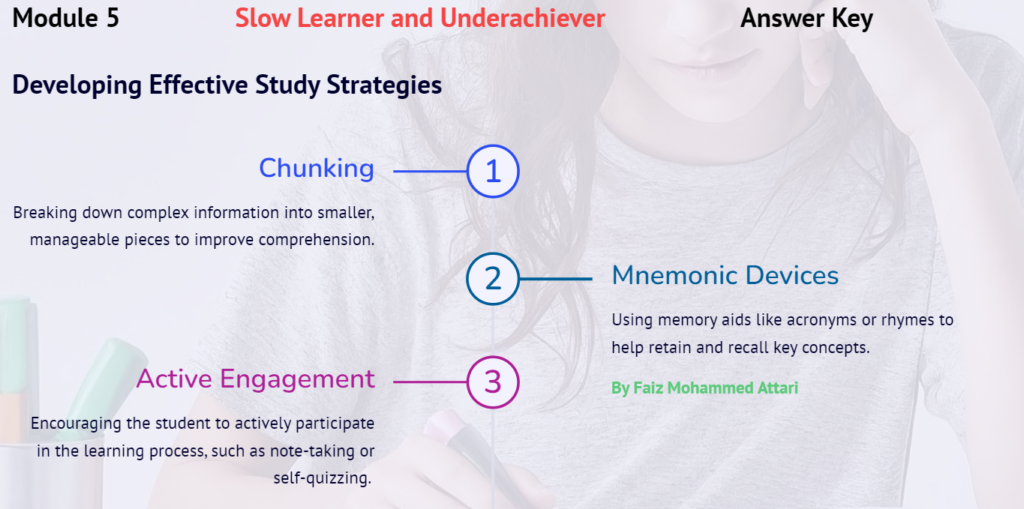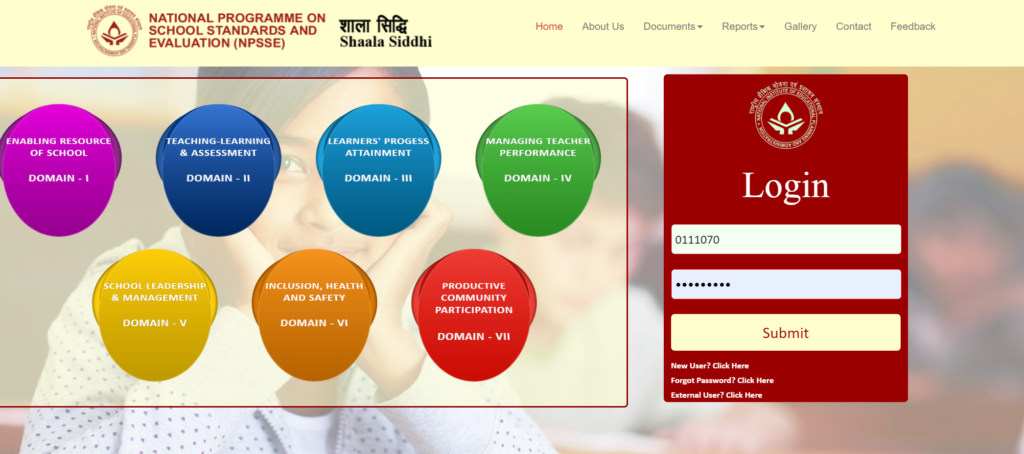Slow Learner and Underachiever: Module 5 Answer key
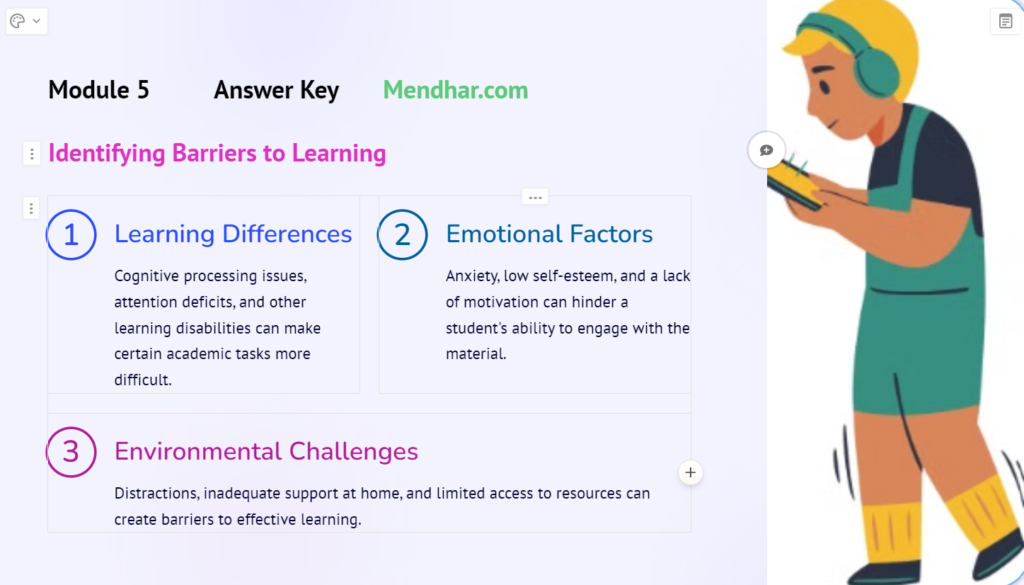
Introduction to Slow Learner and Underachiever: Module 5
In the vast landscape of education, it’s imperative to acknowledge that no two students are alike. Each individual brings with them a distinct combination of talents, areas for improvement, and preferred methods of learning. This diversity enriches the educational experience, fostering an environment where various perspectives are valued and celebrated. However, within this tapestry of uniqueness, certain students may encounter obstacles that hinder their academic progress.
For some students, the journey of learning may not align with the traditional expectations of educational milestones. Despite their best efforts, they may find themselves grappling with concepts that come more easily to their peers, struggling to maintain the same pace of learning. These students may be labeled as slow learners or underachievers, a designation that can carry significant weight and impact their self-esteem.
Module 5 of our educational framework is dedicated to addressing the challenges faced by these students, recognizing that their journey towards academic success is multifaceted and requires a tailored approach. By delving into the intricate dimensions of supporting slow learners and underachievers, we aim to unlock their potential and empower them to thrive in the educational landscape.
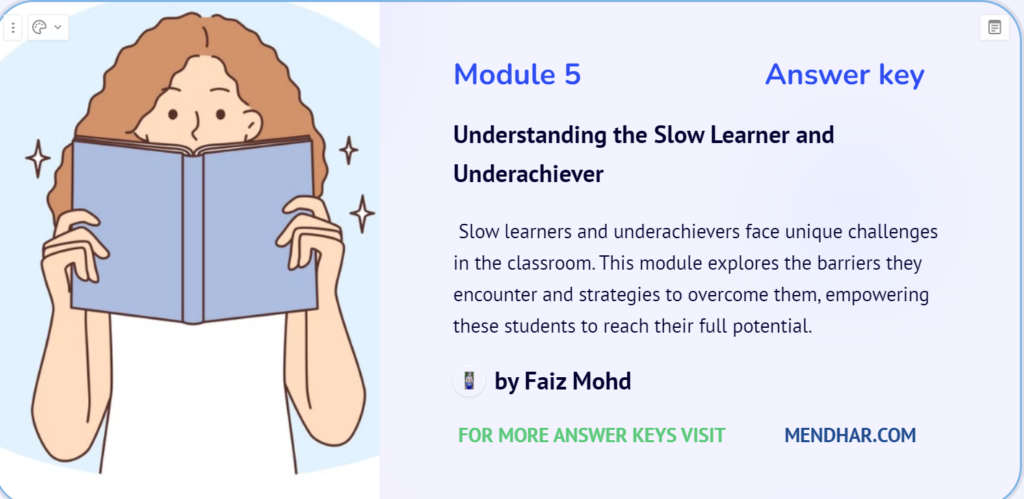
Slow Learner and Underachiever: Module 5 Answer key
1. Emotional factors may also cause slow learning amongst children. These factors include:
– Disliking of a child by any teacher in the class
– Negative parental attitude
– Feeling of inadequacy and lack of self-confidence
– All of the above
– Answer: All of the above🖍️
2. Slow learner’ is a term used for students who achieve all the same developmental milestones as their peers, but at a much slower pace.
– True
– False
– Answer: False🖍️
3. Slow learners may have an IQ level that is below average, they are often ‘intellectually impaired’ individuals.
– True
– False
– Answer: False🖍️
4. Environmental variables that play a vital role in causing slow learning amongst children include:
– Low quality and quantity of food intake
– Adverse parental attitude towards education
– Poor or inadequate opportunities in school
– All of the above
– Answer: All of the above🖍️
5. Underachievement is defined as:
– A discrepancy between a child’s ability and his/her performance in class.
– A lack of interest in studies.
– A high level of academic performance.
– None of the above.
– Answer: A discrepancy between a child’s ability and his/her performance in class.🖍️
6. Performance of an underachiever should be consistently observed for at least five years before starting an intervention.
– True
– False
– Answer: False🖍️
7. Underachievers often lack interest in studies, such as completion of classwork or homework.
– True
– False
– Answer: True🖍️
8. The IQ range of individuals with SLD is average or above 90.
– True
– False
– Answer: False🖍️
9. Children with specific learning disabilities do not need special education services, like individual teaching and training.
– True
– False
– Answer: False🖍️
10. Gifted underachievers have a high discrepancy between their potential and their performance level.
– True
– False
– Answer: True🖍️
11. About 5% to 10% of gifted children with special needs, underachieve in school. (T)
– True
– False
– Answer: True🖍️
12. Children with NDD (ASD, SLD and CP) can also have an IQ from normal to gifted.
– True
– False
– Answer: True🖍️
13. Underachievement is caused by any physical, mental or learning disability.
– True
– False
– Answer: False🖍️
14. Choose the correct option: Environmental variables that play a vital role in causing slow learning amongst children include:
– Low quality and quantity of food intake
– Adverse parental attitude towards education
– Poor or inadequate opportunities in school
– All of the above
– Answer: All of the above🖍️
15. Underachievers often lack interest in studies, such as completion of classwork or homework.
– True
– False
– Answer: True🖍️
Feel free to ask if you need further clarification!
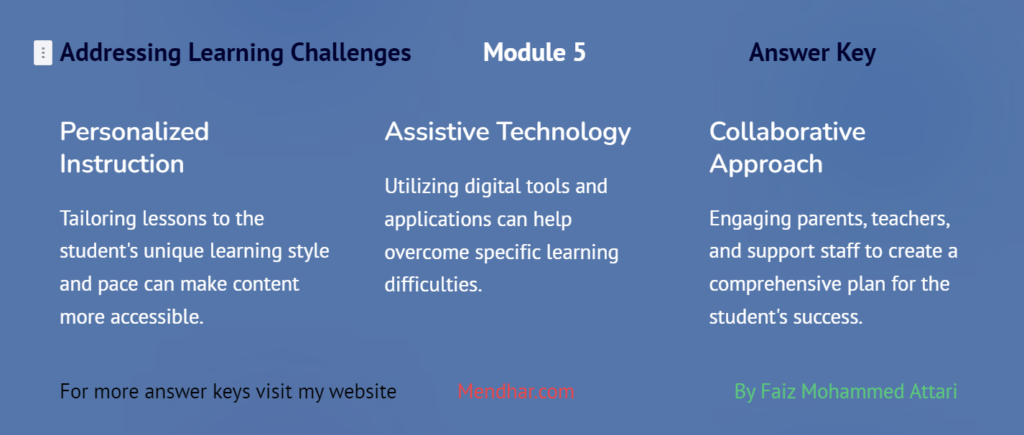
This module takes a holistic view of student development, understanding that academic performance is just one aspect of a student’s overall well-being. It acknowledges the importance of considering factors such as socio-emotional development, individual learning styles, and external influences that may impact a student’s ability to succeed.
By exploring the multifaceted dimensions of student support, Module 5 seeks to dismantle the barriers that impede the progress of slow learners and underachievers. It emphasizes the importance of providing differentiated instruction tailored to the unique needs of each student, recognizing that a one-size-fits-all approach is insufficient in meeting the diverse needs of learners.
Furthermore, Module 5 advocates for a shift in mindset, moving away from deficit-based approaches that focus solely on addressing weaknesses, towards a strengths-based perspective that celebrates the inherent talents and abilities of every student. By fostering a culture of inclusion and empowerment, educators can create environments where all students feel valued and supported in their educational journey.
In essence, Module 5 is a call to action, urging educators to embrace the complexity of student diversity and commit to unlocking the potential of every learner. By recognizing and addressing the unique needs of slow learners and underachievers, we can create an educational landscape that is truly equitable, inclusive, and conducive to the success of all students.
Conclusion:
Slow Learner and Underachiever: MODULE 5 offers a roadmap for empowering students who face challenges in traditional learning environments. By embracing a holistic approach to support, leveraging government initiatives, and fostering collaboration among stakeholders, educators can unlock the potential of every student, paving the way for academic success and lifelong learning.
In summary, Slow Learner and Underachiever: MODULE 5 underscores the importance of recognizing the diverse needs of students and implementing targeted interventions to support their academic growth. Through a combination of educational, psychological, and behavioral strategies, educators can create inclusive learning environments where every student has the opportunity to thrive. With the support of government initiatives and ongoing professional development, the journey towards unlocking the potential of slow learners and underachievers becomes a collective endeavor, guided by the principles of equity, inclusion, and empowerment.
